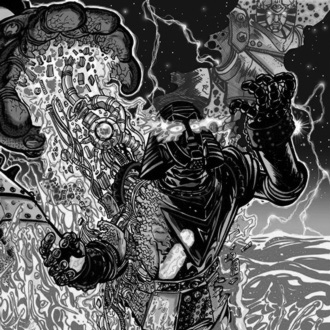For as long as man has existed, we have been fascinated with the idea of other worlds and other creatures that are somehow ‘supernatural’. All around us is the physical world and the reality of that world is something we deal with on a daily basis. But since the dawn of man we have been telling stories of something else, something ‘other’, which might take the form of ghosts, of demons, of aliens or of elves. On the one hand these are horror stories, designed to scare and frighten and that makes them popular around campfires. But at the same time there is something fulfilling and rewarding about them too: not only because we are fascinated by what we can’t explain, but also because if there really are ghosts out there or demons, then it might suggest that we too are more than just a physical assembly of flesh and bones.
But there’s more to it than that. Of course you don’t get thousands of very similar ghost stories and tales of aliens just because people ‘want’ to believe. At the same time there are certain psychological phenomena at work that make us likely to see things that aren’t there and come to conclusions that are fantastical rather than logical. Let’s have a look at what those psychological phenomenons really are and why seeing aliens actually tells us a lot more about the human psyche than it does about what’s out there…
Faces
 Most people by now have seen the image of the ‘face on Mars’ which when photographed from space appeared to portray a Martian face. For a little while, a lot of people believed that this was proof of an ancient alien race, until higher resolution photographs of the area showed that it was nothing more than an optical illusion.
Most people by now have seen the image of the ‘face on Mars’ which when photographed from space appeared to portray a Martian face. For a little while, a lot of people believed that this was proof of an ancient alien race, until higher resolution photographs of the area showed that it was nothing more than an optical illusion.
Why did we all see a face? Simple: the human brain is trained to look for faces whenever it can simply because they are highly relevant to our survival. This is why it’s relatively common to look at the Weetos in your cereal bowl and see them make the shape of a face – it is not because your Weetos are trying to communicate with you.
Stories
Similarly our brain also likes narrative. It likes cause and effect and it likes to create stories out of even random stimuli. This is actually probably where our dreams come from: our ‘pons’ fire in our brains as we cement our memories and our conscious mind picks this up as a load of random imagery and information which it naturally strings into a narrative.
Likewise this is also why someone who experiences a set of unconnected and hard-to-explain events might explain them as being part of an overarching narrative. You feel anxious because you’re hungry but you assume you’re anxious because there’s some presence in the room with you. Then you turn around and see a coat in the window that your brain assumes is a human and suddenly you have a supernatural experience of being stalked by a cloaked figure.
One real life story reports a woman trying to call her husband at work to tell him he forgot his tie for an important meeting. She accidentally misdialled the number she was trying to call though and ended up calling a telephone box just as he was walking past. He popped inside to answer and they were both amazed at the coincidence.
Now you might be tempted to think this would be a case of divine intervention, or of telepathy. That’s because such a random occurrence doesn’t fit with our usual interpretation of ’cause and effect’ and so there must be an outside factor right?
Or could it more likely be that the two numbers were very similar because they were in the same area and that there was a relatively high chance he’d be outside the office as he was on his way there when she noticed? The rest is down to chance, but that’s just it: sometimes things do just happen by chance.
Who Are the Machine Elves?
 A particularly interesting piece of modern mythology is that of the ‘machine elves’ also known as ‘fractal elves’, ‘self-transforming machine elves’ or ‘hyperdimensional beings’ first described by philosopher and ethnobotanist Terence McKenna.
A particularly interesting piece of modern mythology is that of the ‘machine elves’ also known as ‘fractal elves’, ‘self-transforming machine elves’ or ‘hyperdimensional beings’ first described by philosopher and ethnobotanist Terence McKenna.
These are little creatures that came to Terence while on the mind-altering (and highly illegal) drug ‘DMT’. The elves were reportedly encountered while on a trip and it was suggested that they were beings that lived in some alternative dimension:
‘There’s a whole bunch of entities waiting on the other side, saying “How wonderful that you’re here! You come so rarely! We’re so delighted to see you!”‘ Explains McKenna, ‘They’re like jewelled self-dribbling basketballs and there are many of them and they come pounding toward you and they will stop in front of you and vibrate, but then they do a very disconcerting thing, which is they jump into your body and then they jump back out again and the whole thing is going on in a high-speed mode where you’re being presented with thousands of details per second and you can’t get a hold on [them … ] and these things are saying “Don’t give in to astonishment”, which is exactly what you want to do. You want to go nuts with how crazy this is, and they say “Don’t do that. Pay attention to what we’re doing.”‘
The interesting part is that many other users of the drug reported very similar stories and experiences which some people have taken to mean that the elves indeed exist separately from the human psyche and that they are in fact real autonomous beings. Further, those who have experienced these phenomena then go on to explain how they feel enlightened and ‘privileged’ with a sense of wonder and understanding. And McKenna was not even the first to experience such phenomena. Could they be responsible for the fabric of reality? Could these ‘psychonauts’ be seeing the underpinnings of our universe?
Of course again though, when applying a critical lens to these claims it’s easy to see how they might come about. The drug for instance acts principally at the 5-HT2A receptor – the area which is known to be able to alter visual processing and change the way we see the reality around us. This is just like having a virus that changes the display on your laptop. It might look amazing and unreal, but it’s certainly not a window into another world…
Again the brain will begin to analyse all this and attempt to give meaning to it. At the same time, it is also suspected that the drug activates a part of the temporal lobe that has been associated with ‘religious experiences’. It is possible to make people feel as though they are in the presence of God simply by stimulating this area, which explains why they might get a sense of wonder and come away convinced of the significance of their experiences…
Our Cognitive Biases
Something else is at play here too, which is just one of our brain’s many ‘cognitive biases’. In this case we are talking specifically about the ‘confirmation bias’ where our brain looks for things that support our views and ignores the things that do not.
This is something that is used by charlatans who give ‘psychic readings’. When doing ‘cold readings’ these individuals use a practice known as ‘shotgunning’ in which they will fire out a lot of random and vague information that is likely to be true for the person (you’re friends say you’re very shy, you like long walks, you had a painful experience a year ago) and then stick with the stories that seem to illicit a positive response.
Fortunately for the cold reader, as humans we tend to focus on things that seem memorable – the things that go right – and to ignore the misses. So when we come away from our ‘reading’ we’re amazed that they guessed our recent breakup and we forget all about the fact that they suggested we love playing computer games which isn’t true.
This is the same thing that will happen with an experience such as the ‘machine elves’. On DMT users will have any number of hallucinations involving things like jaguars, cars, zombies, household objects and memories all of which is clearly subjective and random. The fact that something like an elf pops up though is what the reports focus on which makes it seem as though there are remarkable similarities between the experiences.
I mean ‘self-dribbling basketballs’… read that back and it shows just how infatuated McKenna is with his own hallucination that has no relevance outside of that experience. He goes on to describe Faberge Eggs and generally to talk a whole load of nonsense…
Similarities Between Accounts
There are all kinds of things that can trigger the brain to have hallucinations and all kinds of situations in which we are likely to experience things our brain will struggle to comprehend. Over the centuries though we have relied on different cultural lenses to explain these phenomenon.
If McKenna were religious for instance, then he would be likely to describe the elves not as elves, but rather as angels and see it as evidence for the existence of God. Were he to have lived hundreds of years ago, he might have described the elves as fairies, or perhaps as demons. Indeed, reports of aliens actually have a lot in common with stories of Nordic Elves, of Fractal Elves and of fairies. They all tend to have big eyes, short bodies and pointy ears for starters… Are these all just symptoms of the same experiences?
Which does suggest that there are some interesting similarities between our accounts of supernatural phenomena. So why is this?
Well chances are that the way we interpret hallucinations and unclear figures is based on universal factors such as our self-image. Notice how all these creatures are humanoid for instance, and have exaggerated features. Some have noted how these exaggerated features (eyes, tongues, hands) reflect our brain’s own ‘body map’ (we have more nerves in the brain dedicated to feeling in the hands and lips than we do for the arms for example). Others point to a similarity between these creatures and human infants – could they be vestiges of early memories of our own infanthood? Could an alien abduction be our brain trying to make sense of early sensations as a baby when our episodic memory was first forming? (Being cradled and examined in a cot)?
Or could it be simply that stories of other encounters with ‘aliens’ has conditioned us to use that premise when interpreting stimuli?
Conclusion
In conclusion then, it is our natural propensity to create narratives, to look for explanations, to see faces and to pay attention to the wrong details that leads to subjective ‘paranormal’ experiences. The fact that we experience similar ‘creatures’ often, is simply due to similarities in the way our brains work.
But does this make the universe any less amazing and miraculous? Of course not. The fact remains that we still do not know where we came from, or what consciousness really is. There is plenty of mystery out there, and understanding the psychology behind ‘supernatural’ phenomenon only strengthens that.



